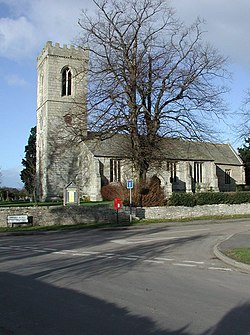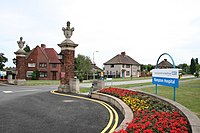Rampton, Nottinghamshire: Difference between revisions
Created page with "{{Infobox town |name=Rampton |county=Nottinghamshire |picture=All Saints' Rampton, Notts. - geograph.org.uk - 1549455.jpg |picture caption=All Saints' parish church |os grid r..." |
No edit summary |
||
| Line 3: | Line 3: | ||
|county=Nottinghamshire | |county=Nottinghamshire | ||
|picture=All Saints' Rampton, Notts. - geograph.org.uk - 1549455.jpg | |picture=All Saints' Rampton, Notts. - geograph.org.uk - 1549455.jpg | ||
|picture caption=All Saints' | |picture caption=All Saints' Church, Rampton | ||
|os grid ref=SK798785 | |os grid ref=SK798785 | ||
|latitude=53.29746 | |latitude=53.29746 | ||
Latest revision as of 21:39, 19 September 2021
| Rampton | |
| Nottinghamshire | |
|---|---|
 All Saints' Church, Rampton | |
| Location | |
| Grid reference: | SK798785 |
| Location: | 53°17’51"N, -0°48’15"W |
| Data | |
| Population: | 1,139 (2011) |
| Post town: | Retford |
| Postcode: | DN22 |
| Dialling code: | 01777 |
| Local Government | |
| Council: | Bassetlaw |
| Parliamentary constituency: |
Newark |
Rampton is a village about six miles east of Retford in the north of Nottinghamshire. The parish is long and thin, extending about seven miles east–west but only about a mile north–south. Its eastern boundary is the River Trent, which here also forms the county boundary with Lincolnshire.
The parish is best known for Rampton Secure Hospital, which is at the hamlet of Woodbeck about a mile and a half west of Rampton village.
The 2011 Census recorded the parish population as 1,139.
History
The name "Rampton" is probably derived from Old English Ramm-tun, meaning "farmstead where rams are kept".[1]
The village was an important manor from Norman times. The old manor house was pulled down around 1720, having been held by the Stanhope and Babington families. All that survives is the gateway, which includes the arms of Babington.
On the eastern boundary of All Saints' churchyard is a mid-16th-century Tudor gateway to Old Manor Farm. It is brick with terracotta panels and is a Grade I listed building.[2] It used to lead to the manor house, which was demolished about 1851.[3]
The area used to be served by Cottam railway station, just over a mile north-east of Rampton village. The station opened in 1850 and closed in 1959.
Parish church
The oldest part of the parish church of All Saints is a 10th-century Anglo-Saxon column in its north arcade. Most of the building is Gothic or later, from the 13th to 17th centuries. The building was restored in 1894.[4]
The west tower is 13th-century and has a ring of six bells. George I Oldfield of Nottingham cast the third bell in 1622 and the fifth bell in 1635. Thomas Hilton of Wath-upon-Dearne cast the fourth bell in 1809. John Taylor & Co of Loughborough cast the treble, second and tenor bells in 1947.[5] The church is a Grade I listed building.[4]
About the village
Rampton has a pub, the Eyre Arms,[6] and a primary school.[7]
Outside links
| ("Wikimedia Commons" has material about Rampton, Nottinghamshire) |
References

- ↑ Mills 1991, "Rampton Notts.".
- ↑ National Heritage List 1276407: Gateway from Manor Farm to churchyard and attached walls west of Manor Farmhouse (Grade I listing)
- ↑ Pevsner & Williamson 1979, p. 292.
- ↑ 4.0 4.1 National Heritage List 1233879: Church of All Saints (Grade I listing)
- ↑ Dawson, George (1 January 2014). "Rampton All Saints". Dove's Guide for Church Bell Ringers. Central Council for Church Bell Ringers. http://dove.cccbr.org.uk/detail.php?searchString=Rampton&Submit=+Go+&DoveID=RAMPTON+N.
- ↑ "the eyre arms at rampton village". http://www.eyrearmsrampton.com/.
- ↑ "Home | Rampton Primary School". https://www.ramptonprimary.co.uk/.
- Mills, Anthony David: 'A Dictionary of British Place-Names' (Oxford University Press, 2003) ISBN 978-0-19-852758-9
- Nikolaus Pevsner: The Buildings of England: Nottinghamshire, 1951; 1979 Penguin Books ISBN 978-0-300-09636-1
- Thoroton, Robert; Throsby, John (1796). Thoroton's History of Nottinghamshire: Republished With Large Additions By John Throsby. 3. Nottingham. pp. 241–248. http://www.british-history.ac.uk/thoroton-notts/vol3/pp241-248.
